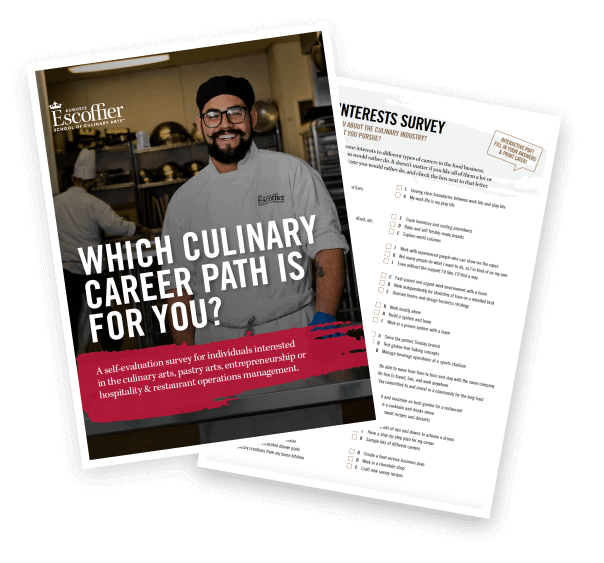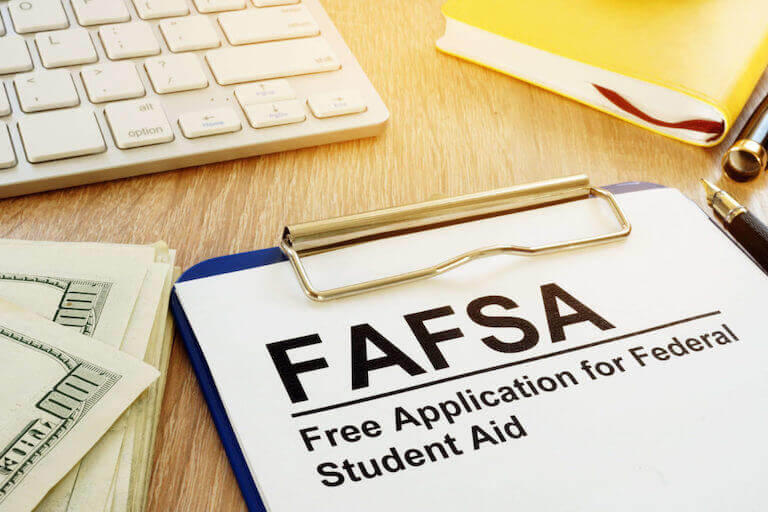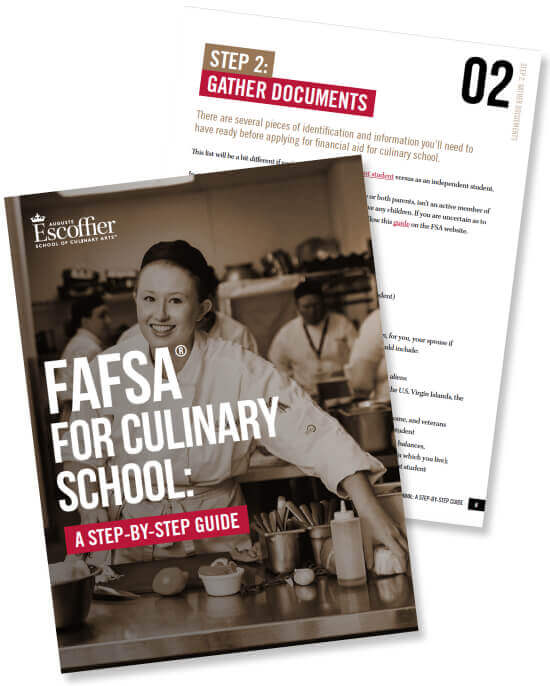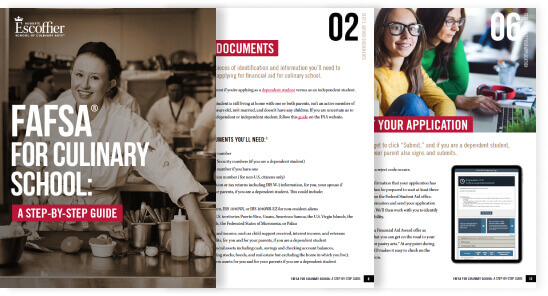The decision to go to culinary school usually brings up a couple of questions: How much does culinary school cost, and how will you be able to pay for it?
At the time of publishing this article, the tuition for Auguste Escoffier School of Culinary Arts’ 60-week Online Diploma in Culinary Arts and Operations is $21,751****.
At first glance, you might think this makes culinary school appear to be out of reach. But keep in mind that the actual net cost of school is different for everyone, depending on your current life circumstances and what kind of funding you may receive.
No matter your present socioeconomic background or particular life circumstances, there’s usually a financial plan for your specific situation to get you all the way to graduation…and the decision to attend culinary school could ultimately help you find a career you love. But before we get ahead of ourselves, let’s understand more of the details behind school tuition costs, and how you might pay for it.
How Much Does Culinary School Cost?
How much culinary school can cost depends on the type of program you choose (in-person or online), the location (Boulder or Austin), and the program itself. Escoffier offers diplomas and/or degrees in Culinary Arts, Baking & Pastry Arts, Food Entrepreneurship, Plant-Based Culinary Arts, Hospitality & Restaurant Operations Management, and Holistic Nutrition and Wellness.
Escoffier’s program tuition ranges from $18,094 to $37,370. Keep reading to find out how you might be able to reduce this figure.
Head over to our tuition page for a full breakdown of costs and fees for all of our programs.
What Do Tuition and Fees Actually Get You?
What constitutes tuition costs, not just at culinary schools, but at all quality educational institutions? As you’ll see, when you invest in a quality education, you’re paying for quality chef instructors, educational platforms, ongoing research, and more.
Remember, most educational institutions have to pay qualified instructors who have industry experience and/or academic credentials in their respective fields. These are the people who can become your mentors and guides, the people who may help you achieve your culinary career goals. Obviously, you don’t want to forgo that, and neither do we!

When you choose a culinary institution for your studies, you want to ensure that you are educated by Chef Instructors who can help you discover a variety of approaches to success in the culinary arts.
Culinary colleges and schools often attract culinary professionals who have worked as Executive Chefs and/or who have credentials like Master Baker, Certified Master Chef, Certified Culinary Administrator, and other industry recognitions. You might think of these designations in the culinary industry similarly to the way other industries have credentials such as MBA, CPA, and PhD.
Costs That Go Into a Culinary School’s Tuition:
Here are just a few of the costs that tuition can pay for at culinary school:
- Learning Technology Platform & Tools
- Curriculum and Course Planning & Development
- Kitchen Toolkit
- Externship Program Services
- Career and Job Placement Services
- Alumni Programs & Networking Platforms
- Other Staff (Admissions, Counseling & Coaching, etc.)
To facilitate one-on-one interactions and personalized feedback for online students, there are technology costs required to build, maintain, and update online learning tools.
Schools must also invest in ongoing research for improving the quality of education itself so that what is taught are current best practices in the industry.
Finally, accreditation processes can help ensure that peer-reviewed industry educational standards are met or exceeded.
How Can You Pay for Culinary School?
Now that we’ve covered what goes into tuition costs, let’s dive into the logistics of paying for culinary school. The good news is that decades ago, the federal government passed the Higher Education Act of 1965, which, through the Office of Federal Student Financial Aid, helps make college or career school possible for more than 17.6 million students each year.
We’ve already covered the fact that, for many, instead of paying the program’s listed tuition and fees, the actual net cost could be much lower. There are numerous opportunities for students to receive scholarships and grants, in addition to federal student loans for those who apply and qualify.
We’ve previously detailed various scenarios on how long it takes to pay back student loans. The investment you’re making is for the purpose of opening more doors, potentially leading to more opportunities and a higher income than you would otherwise have if you just worked your way up in a professional kitchen.

Take the Culinary Career Survey
We’ve compiled a checklist of all of the essential questions into one handy tool: career options, culinary interest surveys, educational opportunities, and more.
Financial Aid Is Available to Those Who Apply and Qualify
A common disclaimer that you’ll see at most educational institutions is, “Financial aid is available to those who apply and qualify.” This ensures that higher education institutions don’t misrepresent costs, and how financial aid works, for prospective students.
If you happen to fall into those who do not qualify for aid, don’t despair! At Escoffier, our Financial Aid department can work with you to help you understand all of your options, including flexible payment plans, scholarships, and Gift of Education certificates.

Financial Aid form that most students fill out for eligibility.
Here’s How Financial Aid Can Work at Culinary School… In a Nutshell
- Reach out to the Admissions team at your school to let them know your intention to attend that school.
- Create your Federal Student Aid ID (FSA ID) on the government’s student aid website.
- Fill out the government’s Free Application For Federal Student Aid (FAFSA®) form.
- The FAFSA will give you your Estimated Family Contribution (EFC), Cost of Attendance (COA), and Financial Need.
- Talk to a Financial Advisor at your school to formulate your plan.
- Apply for scholarships and grants.
- Apply for loans.
- Go to school!
- Keep applying for scholarships and grants!
A Few More Tips on Paying for School
When you strategize ways to pay for school, you’ll most likely have to leverage multiple resources. Here are a few quick tips on ways to prepare.
Involve Your Parents Early
If you’re a dependent, it’s best to have your parents or guardians on the phone with you when you talk to your Financial Advisor. Remember, even if you’re over 18, you might still be considered a “dependent” for the purposes of qualifying for Federal Student Aid. Parents who choose to assist their children in paying for their education have options for PLUS loans – a Federal Direct Student Loan program.
Earn Your Title IV Funding by Going to Class and Getting Good Grades
Federal financial aid, also known as “Title IV funding,” isn’t doled out without requirements. If you qualify for financial aid, you don’t just receive your funding… you have to “earn it.” After the Department of Education determines a student’s eligibility for Federal or “Title IV” funding, the Department of Education will disburse funds to the school in which the student is attending and will continue to do so as long as the student continues to be enrolled and pass the courses in which they are taking.
Keep Applying for Outside Scholarships
There are dozens of industry sources for scholarships! For example, the National ProStart Invitational is the country’s premier secondary high school competition that focuses on culinary arts and restaurant management. Around 400 students compete in skill-based tests in hopes to earn educational scholarships. In 2022, ProStart Invitational awarded more than $200,000 to student competitors.
As long as you are a student enrolled at Escoffier, we may be able to rework the scholarship funding into financial aid later. So it’s a good idea to just keep applying for scholarships, even after enrollment.
Pay Your Loans on Time and On Schedule
Maintaining a good credit score makes life easier in so many ways, so do everything you can to pay your loans on time. When you consistently make loan payments in a timely manner, your credit score can start to improve, as lenders can see that you are financially responsible. If you have trouble with making payments, it’s always better to work with your lender and come up with a plan than to simply default. The Department of Education is the lender of Federal Loans and if you are unable to make the payments, it is important to keep in contact with them so they can speak to you about other possible options.
“Utilizing a student loan is not necessarily a bad thing. If you choose to use a student loan, be a smart borrower. Construct a budget and only borrow what is needed to cover your school expenses such as tuition. The Financial Aid office at Escoffier is here to answer your questions and help you make the right decision.”*
Jason Rodriguez, Escoffier Director of Financial Aid
Don’t Wait to Invest in a Culinary Education
There are always avenues to make your dream happen. We live in a world where quality matters. New employees are often expected to know what to do and contribute right away. Getting educated in Culinary Arts, Baking & Pastry Arts, Plant-Based Culinary Arts, Holistic Nutrition and Wellness, Food Entrepreneurship, or Hospitality & Restaurant Operations Management could be just the edge you need.
Now you may understand a lot more about the costs and payment options for culinary school. You should have a better idea of what it might take for you to realize your dream.
And that’s a whole other way of looking at costs. What’s the cost of not following your passion? Take the next step and explore what a culinary education might look like for you…
…and then get a plan in place to make it happen.
More Reading on How to Plan for Culinary School:
- How Financial Aid Works: FAQS About Funding for Culinary School
- FAFSA for Culinary School: A Step-By-Step Guide
- Can You Pay for Culinary School with Student Loans?
This article was originally published on April 2, 2021, and has since been updated.
*Information may not reflect every student’s experience. Results and outcomes may be based on several factors, such as geographical region or previous experience.
**Consider your situation and resources to determine what is affordable and on budget, for you.
***Please view the most recent requirements to determine what is needed for the Expected Family Contribution (EFC).
****Listed prices include a non-refundable $25 application fee. A computer, tablet, or mobile phone is required to participate in our online programs. If you do not already have a device, you may choose to pay an additional $250 Technology Fee which covers the cost of a Google Chromebook. Prior to starting, a $25 deposit is required to receive your Google Chromebook.
1Based on comparable student population data for Austin and Boulder as currently reported in Integrated Postsecondary Education Data System (IPEDS)

 “Utilizing a student loan is not necessarily a bad thing. If you choose to use a student loan, be a smart borrower. Construct a budget and only borrow what is needed to cover your school expenses such as tuition. The Financial Aid office at Escoffier is here to answer your questions and help you make the right decision.”*
“Utilizing a student loan is not necessarily a bad thing. If you choose to use a student loan, be a smart borrower. Construct a budget and only borrow what is needed to cover your school expenses such as tuition. The Financial Aid office at Escoffier is here to answer your questions and help you make the right decision.”*

